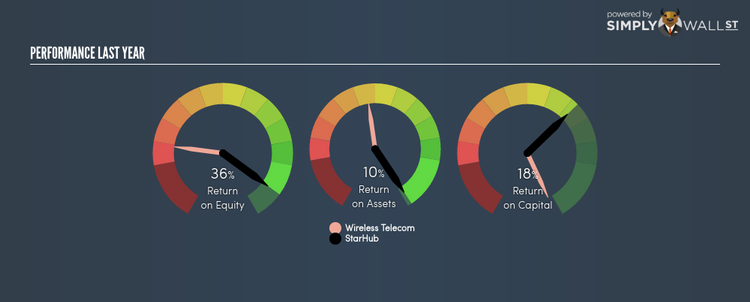Should You Expect StarHub Ltd (SGX:CC3) To Continue Delivering An ROE Of 36.19%?

StarHub Ltd (SGX:CC3) outperformed the Wireless Telecommunication Services industry on the basis of its ROE – producing a higher 36.19% relative to the peer average of 12.71% over the past 12 months. Superficially, this looks great since we know that CC3 has generated big profits with little equity capital; however, ROE doesn’t tell us how much CC3 has borrowed in debt. We’ll take a closer look today at factors like financial leverage to determine whether CC3’s ROE is actually sustainable. Check out our latest analysis for StarHub
What you must know about ROE
Return on Equity (ROE) is a measure of StarHub’s profit relative to its shareholders’ equity. It essentially shows how much the company can generate in earnings given the amount of equity it has raised. In most cases, a higher ROE is preferred; however, there are many other factors we must consider prior to making any investment decisions.
Return on Equity = Net Profit ÷ Shareholders Equity
Returns are usually compared to costs to measure the efficiency of capital. StarHub’s cost of equity is 8.51%. Given a positive discrepancy of 27.67% between return and cost, this indicates that StarHub pays less for its capital than what it generates in return, which is a sign of capital efficiency. ROE can be dissected into three distinct ratios: net profit margin, asset turnover, and financial leverage. This is called the Dupont Formula:
Dupont Formula
ROE = profit margin × asset turnover × financial leverage
ROE = (annual net profit ÷ sales) × (sales ÷ assets) × (assets ÷ shareholders’ equity)
ROE = annual net profit ÷ shareholders’ equity
Basically, profit margin measures how much of revenue trickles down into earnings which illustrates how efficient the business is with its cost management. The other component, asset turnover, illustrates how much revenue StarHub can make from its asset base. And finally, financial leverage is simply how much of assets are funded by equity, which exhibits how sustainable the company’s capital structure is. Since financial leverage can artificially inflate ROE, we need to look at how much debt StarHub currently has. At 147.46%, StarHub’s debt-to-equity ratio appears balanced and indicates the above-average ROE is generated from its capacity to increase profit without a large debt burden.
Next Steps:
ROE is one of many ratios which meaningfully dissects financial statements, which illustrates the quality of a company. StarHub’s above-industry ROE is encouraging, and is also in excess of its cost of equity. ROE is not likely to be inflated by excessive debt funding, giving shareholders more conviction in the sustainability of high returns. Although ROE can be a useful metric, it is only a small part of diligent research.
For StarHub, I’ve put together three key factors you should further research:
Financial Health: Does it have a healthy balance sheet? Take a look at our free balance sheet analysis with six simple checks on key factors like leverage and risk.
Valuation: What is StarHub worth today? Is the stock undervalued, even when its growth outlook is factored into its intrinsic value? The intrinsic value infographic in our free research report helps visualize whether StarHub is currently mispriced by the market.
Other High-Growth Alternatives : Are there other high-growth stocks you could be holding instead of StarHub? Explore our interactive list of stocks with large growth potential to get an idea of what else is out there you may be missing!
To help readers see pass the short term volatility of the financial market, we aim to bring you a long-term focused research analysis purely driven by fundamental data. Note that our analysis does not factor in the latest price sensitive company announcements.
The author is an independent contributor and at the time of publication had no position in the stocks mentioned.

 Yahoo Finance
Yahoo Finance 

